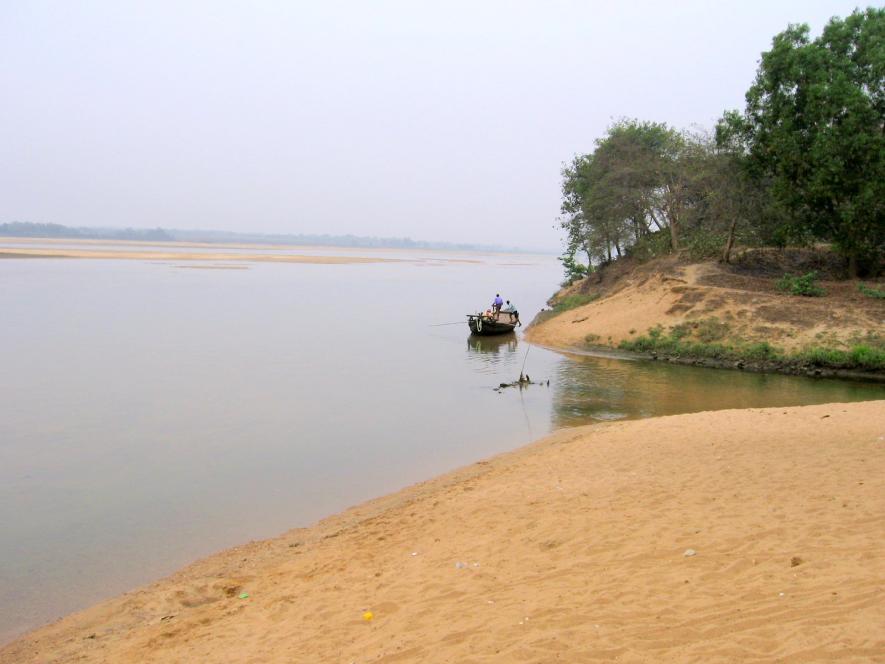Will Damodar River Again be Bengal’s ‘Sorrow’?

Image Courtesy: Wikipedia
Kolkata: Will the Damodar river relapse into its unwelcome identity of ‘Sorrow of Bengal’ that stuck for many years until the end of the 1950s? That identity gradually faded when the Damodar Valley Corporation (DVC) executed multiple projects to moderate floods. The concerns come in the context of the devastation caused by floods in the state’s southern districts following the release of vast quantities of water by the DVC from its Maithon and Panchet barrages between September 30 and October 2. An estimated 22 lakh people in Bankura, Birbhum, Hooghly, Paschim Bardhaman and Paschim Medinipur districts became victims of the resultant misery. The floods also damaged agricultural activity- the fallout of which is still visible in the 25-40% increase in vegetable prices in the city and surrounding areas.
There is an unreported part too. From the night of September 29 till the late afternoon of the following day, cloudbursts and rainfall (approx. 370 mm) led to forced outage of five of the eight units of the DVC’s 2,340 MW Mejia thermal power complex in Bankura district. Inundation disrupted the schedule of incoming coal supplies. While the issues, in this case, were of saving the plants and restoring power supply to industrial and domestic consumers, the devastation caused by the floods warranted immediate, large-scale relief, rehabilitation and restoration measures for the affected people.
West Bengal’s chief minister Mamata Banerjee, aggrieved by the sudden turn of events, wrote to the Prime Minister on October 5, seeking his immediate intervention. The chief minister ascribed the tragedy to the unplanned, uncontrolled release of water by the DVC, without an advance intimation to the state authorities. In her letter to Narendra Modi, she stressed the need for short and long-term measures to tackle the problem of flooding in south Bengal and urged him to see that the concerned Union ministry – in this case, power – engages with the governments of West Bengal and Jharkhand, and the DVC for working out a permanent solution. She reminded Modi that West Bengal happened to be the lower riparian state, as Jharkhand’s geographical position is upstream of the Damodar river.
The DVC contended that a decision on the discharge of water is always made by the Damodar Valley Reservoir Regulation Committee, which has representatives from both the state governments. The decision is conveyed to them six hours before the actual release of water through emails and a WhatsApp group involving all the stakeholders. The regulation committee is headed by Member (RM) in the Central Water Commission (CWC), New Delhi.
Among the Opposition parties, only the Bharatiya Janata Party (BJP) alleged that it all happened because of the chief minister’s preoccupation with her bye-election campaign and the administration’s neglect of repair and restoration of weak embankments.
Given the available indications of Trinamool Congress and Banerjee's national-level ambitions, it is a matter of interpretation as to whether what the chief minister said about Jharkhand has political overtones. She repeatedly said that Jharkhand is a friendly neighbour and should consult West Bengal before releasing vast quantities of water from its dams, giving the state some time to prepare.
[The provision for the reservoir regulation committee and the DVC ownership structure rule out any right to Jharkhand to decide on the release of water. The committee is a consultative forum for a technical decision. The location of Maithon and Panchet in Jharkhand is not an issue. However, the question of Jharkhand’s responsibility will arise if it discharges water from the state-owned Tenughat dam in the case of excessive rainfall.]
The wild and erratic Damodar had been the reason for severe floods on many occasions, particularly the one in 1943 that caused massive devastation in the region. The authorities had then constituted a committee, with well-known physicist Meghnad Saha and the then Maharaj of Burdwan as its members. It suggested the creation of a multi-purpose authority on the model of the Tennessee Valley Authority (TVA) of the US. Later, one of the senior TVA engineers, W.L. Voorduin, was actively involved with follow-up work. Dr B.R. Ambedkar was also actively engaged in concretising the proposed authority’s developmental role for the Damodar basin.
The DVC came into existence on July 7, 1948, based on the DVC Act of 1948 (Act XIV) passed by the Central legislature and assented by the Governor-General on March 27, 1948. The Act provided equal shareholding control (not the usual equity route, but a profit-sharing/distribution route) for the three partners – the Centre, West Bengal and Bihar (later Jharkhand). The roles assigned included flood moderation, irrigation, water supply for industrial and domestic use, thermal and hydel power generation (including transmission and distribution), afforestation and control of soil erosion. The release of water at times of excessive rainfall and the resultant floods of varying intensity keeps the DVC in the news during the monsoon season.
NewsClick spoke to several official and trade union sources to get their assessment of the issues with the authority's flood moderating role. General secretary of DVC Shramik Union (affiliated to the Centre of Indian Trade Unions) Jiban Aich said: “To the best of my knowledge, originally seven dams were proposed but the under the then prevailing circumstances, five were constructed– Tilaya (February 1953), Konar (October 1955), Durgapur barrage (1955), Mathon (September 1957) and Panchet (December 1959). Except for the Durgapur barrage, which is in West Bengal, other units are in Jharkhand. The proposed sixth unit (at Balpahari in West Bengal’s Jhargram district) and the seventh (at a suitable location in Jharkhand) were not taken up.
Some years back, Konar, Maithon and Panchet's rehabilitations were taken up by the DVC under the CWC's Dam Rehabilitation and Improvement Project at the cost of Rs 143 crore. But, its exercise to construct a new dam at Balpahari, which has CWC's assent, faced stiff resistance from local people on the issue of land acquisition.
"It is a highly politicised issue in this part of the country; we waited for a long time in the hope that our effort to convince the utility of the venture would be fruitful, but it did not. Ultimately, we had to drop the idea. The additional one for Jharkhand has not been attempted; land acquisition is an issue there too. The states don't help us out in this regard," official sources told NewsClick.
As a result, the water holding capacity is lesser than recommended. Matters have also assumed severe proportions because regular desilting on a scale warranted has not been undertaken over the years. The water holding capacity is now down to 50% of when it was created. Extensive desilting is also long overdue for the DVC's 2,494 km canal network – 136.8 km Left Bank main, 88.5 km Right Bank main and 2,069 km of branch canals. It has to be a long-drawn exercise at a considerable cost. The cost was put at Rs 50,000 crore by an official source. The three co-owners have maintained silence over this despite knowing that this is a significant problem.
These ground realities have given rise to the apprehension that the Damodar river may once become Bengal’s sorrow. As initially suggested by experts, the preparation of a master plan for desilting and its phased execution and construction of two more dams call for a more prominent role of the Union government. Equal co-ownership set a unique example of cooperative federalism in the 1940s, but the Centre-state and state-state dynamics have undergone a sea change over the past two decades. Whether the West Bengal chief minister’s recent letter to the Prime Minister moves North Block to do what is worthwhile and mark a break from the past is to be seen, as told by knowledgeable quarters to NewsClick, while summing up the situation.
The writer is a Kolkata-based senior freelance journalist. The views are personal.
Get the latest reports & analysis with people's perspective on Protests, movements & deep analytical videos, discussions of the current affairs in your Telegram app. Subscribe to NewsClick's Telegram channel & get Real-Time updates on stories, as they get published on our website.
























